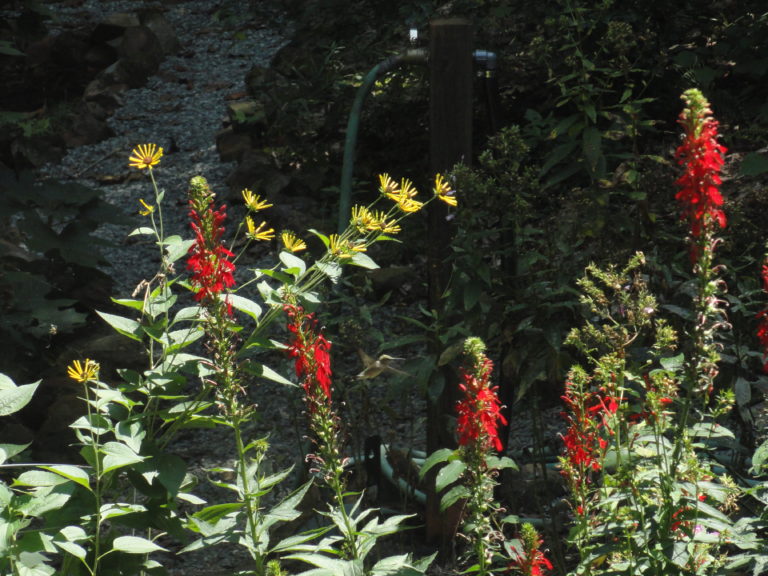Cardinalflower is a handsome wildflower known for it vibrant red (occasionally white or rosie pink) floral spikes on sturdy, upright stems three to four feet tall and occasionally taller. It is valued by gardeners not just for the deep scarlet color and relatively tall, erect form but also because it attracts hummingbirds to the garden. The flowers consist of long tubes, are not easily navigated by short-tongued insects and depend on the hummers and long-tongued butterflies for pollination. Cardinalflower is widely occurring in nature, found in wet or damp, sunny or mostly sunny habitats throughout the eastern US as well as south central states all the way to California. Curiously for such a widespread plant, is is regarded as finicky and short lived. This may be because, according to Cullina (Growing and Propagating Wildflowers) Lobelias are not true perennials since the flowering stem and its associated roots die after setting seed. They are perennial in effect only because new offsets grow from the axils of the lowermost leaves and quickly put down their own abundant white roots. For the gardener who understands this, Cardinalflower’s erect habit can lend late season height and stunning color to a pollinator garden, pondside, or damp woodland opening with rich, moist soil and full sun or partial sun, for many years. Recipient of the Royal Horticultural Society’s Award of Garden Merit.
NURSERY HOURS
Wednesday: 10-4 Thursday: 10-6 Friday-Saturday: 10-4 Sunday: 12-4
Lobelia cardinalis

Key Info
Common Names: Cardinalflower
Family Names: Campanulaceae (Bellflower Family)
Plant Type: Herbaceous perennial
Leaf Retention: Deciduous
Flower Color: Red
Additional Info
Habit: There are many upright, mostly unbranched stems from center of plant; the central stem terminates in a spike-like raceme of showy red flowers; basal rosettes are connected by a system of rhizomes.
Height: 2' to 4'
Spread: 2'
Soil Conditions: Wet to moist; pH acidic to neutral; humus-rich soil, medium loam, clay loam, sandy, sandy or gravelly loam, clay.
Leaves: The lower portion of the erect stem is lined with alternate, lance-shaped leaves generally 3 inches long and 3/4 inches wide but up to 6 inches long and 1½ inches wide, lanceolate to oval, with toothed margins, and curling upward along their central veins. The lower leaves have short petioles, while the upper ones are sessile. The undersides of the leaves usually have fine hairs.
Flowers (or reproductive structures: The corolla of each individual flower, ~1½ inch x 1 inch, has three spreading lower petals and two upper petals, all united into a narrow, upright tubular structure (fused stamens and pistil) that terminates in grayish white reproductive organs that nod downwards. The corolla has a slit on each side near the base. The green calyx is deeply divided into 5 linear teeth that spread outward (Illinois Wildflowers). The erect flowering spike, 1 to 2 feet tall, opens from the bottom up. The blooming period occurs from late summer to early fall, lasting about 5-6 weeks. There is no floral scent.
Fruit: The seeds come in two-celled, many-seeded capsules opening at the top. They are small, tan colored and ribbed and can be carried aloft by the wind in late summer/fall.
Natural Distribution: Sunny or semi-sunny areas near sources of water such as ditches, wood edges, stream banks, roadsides, wet meadows, prairies, swamps, open woodland areas where moist depressions occur.
USDA Hardiness Zone: 3 to 9
USDA Wetland Indicator Status in NC: FACW
Pollination: Ruby-Throated Hummingbirds, butterflies
Wildlife Connections: The nectar of the flowers attracts the Ruby-Throated Hummingbird and various Swallowtail butterflies, including the Black Swallowtail, the Spicebush Swallowtail and the Pipevine Swallowtail, as well as longer tongued bees. The leaves support larvae of a range flies and moths. The seeds are too small to be of much interest to birds. All Lobelia species produce a toxic latex which discourages mammalian herbivores. While it's a beautiful plant, the ecological value of Cardinal Flower to wildlife is considered relatively low (Illinoiswildflowers.info).
Propagation: Seeds. Benefits from cold moist stratification treatment.
